1 min read
Enterprises Need to Build a Ransomware Strategy to Combat the Recent Locky Ransomware Attack

December 24, 2024
Copyright 2023, IT Voice Media Pvt. Ltd.
All Rights Reserved

 In the wake of Locky Ransomware attack and the Government of India issuing alert across the country, Trend Micro Incorporated, a global leader in cyber security solutions, has stated that there are no incidence being reported in India at present. As per Trend Micro, the ransomware is not likely to be on the scale of Wannacry and Petya ransomware, which relies on Microsoft vulnerability in Windows XP. Trend Micro has also provided precautionary measures on how to stop the Lukitus variant of Locky ransomware from spreading.
In the wake of Locky Ransomware attack and the Government of India issuing alert across the country, Trend Micro Incorporated, a global leader in cyber security solutions, has stated that there are no incidence being reported in India at present. As per Trend Micro, the ransomware is not likely to be on the scale of Wannacry and Petya ransomware, which relies on Microsoft vulnerability in Windows XP. Trend Micro has also provided precautionary measures on how to stop the Lukitus variant of Locky ransomware from spreading.